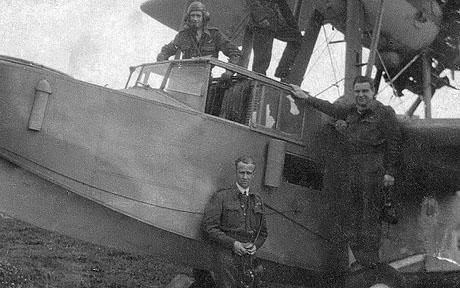 Friday - January 07, 2011
Friday - January 07, 2011
OBIT …. SIR JOHN OWEN … WHO FRIGHTENED OFF 8 WHITE CLAD VIRGINS … YEAH, REALLY.
Sir John Owen RIP
Sir John Owen, who has died aged 85, was a much admired High Court judge and presided at a number of ground-breaking cases.
Charming, even-handed and compassionate, he was also an exponent of Lord Denning’s judicial approach of not allowing the letter of the law to get in the way of justice.A case in point was RvR (1991), in which Owen was the trial judge and which overturned the common law position that a man could not be found guilty of raping his wife.
The defendant was accused of attempting to rape his estranged wife after forcing his way into her parents’ house, where she had gone to live while seeking a divorce. He pleaded guilty after Owen’s unprecedented ruling that by the circumstances of their separation the wife had withdrawn her implied consent to sexual intercourse given upon marriage.Owen’s decision was later upheld in the Court of Appeal by the Lord Chief Justice, Lord Lane, who declared that this “common law fiction” had become “anachronistic and offensive” in modern society, and also by the House of Lords, where Lord Keith said that marriage was no longer “one in which the wife must be the subservient chattel of the husband”.
John Arthur Dalziel Owen was born on November 22 1925 at Stockport, then part of Cheshire. He had a religious upbringing and his Christian faith underpinned his approach to life and the law.
After Solihull School, he was commissioned in the 2nd King Edward VII’s Own Gurkha Rifles, and spent two years in India in the run-up to independence, which he came to see as not just inevitable but also desirable.
On one occasion he saved his men from an angry mob by showing a presence of mind well in advance of his 21 years. Encountering a roadblock consisting of eight young virgins, dressed in white and lying in the path of his armoured vehicles, he ordered a good-looking young Gurkha to walk forward and drop his trousers.
The virgins ran off screaming and the column moved on without a shot being fired.
A kind and generous character with a lively sense of humour, Owen was an accomplished raconteur and much sought after to give speeches. In retirement, he worked hard for a number of charitable organisations.
John Owen, who died on December 9, is survived by his wife and by their son and daughter.
Posted by peiper
Filed Under: • OBITITUARIES •
• Comments (0)
 Friday - December 31, 2010
Friday - December 31, 2010
‘Rosie the Riveter’ war recruitment poster girl dies at 86 …
‘Rosie the Riveter’ war recruitment poster girl diesGeraldine Doyle, who was the inspiration for a popular US Second World War recruitment poster featuring the slogan “We Can Do it!” has died at the age of 86.
By Nick Allen, Los Angeles

Mrs Doyle was a 17-year-old working in a metal factory in Ann Arbor, Michigan when she featured on the “Rosie the Riveter” poster wearing a red and white polka dot bandana and flexing her bicep.
The image became a visual representation of the millions of women who worked in factories in the US during the war effort and was later adopted by the feminist movement.
Mrs Doyle’s photograph was taken by chance by a United Press International photographer and it then became the basis for the poster which was produced in 1942 by the Westinghouse Electric Corporation to raise the morale of workers.
The public soon began associating the poster with a hit song called “Rosie the Riveter” and the name stuck.
In reality, Mrs Doyle only worked at the factory for two weeks before moving to a job in a book shop and pursuing her passion for playing the cello.
Does anyone else wonder how it was possible for her to not know until 1984? Just seems odd.
She wasn’t employed as a riveter for long. Bet these ladies were. Newsweek 1943


Posted by peiper
Filed Under: • OBITITUARIES • USA • War-Stories •
• Comments (7)
 Wednesday - December 22, 2010
Wednesday - December 22, 2010
AN OBIT … AMERICAN DERRING DO, A YANK AMERICANS MOST LIKELY NEVER HEARD OF.
A very unusual obit and bio ...
Once upon a time guys like this actually did exist. And this one is one of ours.
An American ...
I’d be willing to bet not many newspaper in the USA would give him this much space. For those who don’t know btw ... Brit papers like The Telegraph, are HUGE. They are larger in actual size then those found in USA. Pages are 23 inches long by almost 15 wide. And they gave this fellow most of one page.
(A side note. This will be my only post today.)
Frank Bessac
Frank Bessac, who died on December 6 aged 88, was one of two survivors of an epic and ill-fated trip led by the CIA in the early days of the Cold War which took him from the borders of Mongolia to the Tibetan capital Lhasa amid Great Game-style efforts to stymie communists both in China and in Russia.
Bessac, who went on to become a social anthropologist, had officially resigned as a spy by the time he undertook the journey. But his companion on the trip was a CIA officer believed by some to have been ordered to arm the Tibetans against the insurgent Chinese People’s Liberation Army.
A Mandarin speaker, Bessac had himself joined the CIA on its formation in 1947, gathering intelligence on both Nationalist and Communist activity as China descended into civil war. He was considered for a senior role in the organisation, but left when he discovered that this meant working covertly and would stop him pursuing a new-found interest in Mongolia. Instead, he studied Classical Chinese and Mongolian at Fu Ren University, Peking, where he wore the robes of a Chinese scholar.
In spring 1948 Bessac and Prince De, a descendant of Genghis Khan, distributed food aid for the US State Department’s Mongol Branch of the China Relief Mission, for which Bessac was made an honorary Mongol and a Knight of Genghis Khan. In September he was awarded a Fulbright scholarship and decided to deepen his knowledge of Mongolian and the life of the pastoral nomad.
Early in 1949 he travelled to Dingyaunying, near Lanzhou, central China, where he settled and engaged a language teacher. In August he attended a congress, summoned by Prince De, which proclaimed the formation of a provisional Mongolian Republic. But within days the whole area became engulfed in fighting between the Nationalists and Communists, and Bessac was forced to flee. After travelling 200 miles north-west by camel to Shandan, he hitched a ride on a truck to Hami, then travelled by air to the remote western city of Urumqi, where he was astonished to be met by a car flying the Stars and Stripes.
The car belonged to the American vice-consul, Douglas Mackiernan, who was about to evacuate the city after the closure of the consulate. Mackiernan was, in fact, an undercover CIA agent who was in the region principally to spy on the first Soviet atom bomb test, which was eventually staged across the border from Urumqi at Semipalatinsk on August 29 1949.
When Mackiernan used Bessac’s old code word, it was clear that he knew Bessac had been a CIA man too. Mackiernan asked him whether he would be interested in helping Osman Bator, the anti-Communist Kazakh leader of Chinese Turkestan. Feeling that it would be “interesting to spend time in a Kazakh camp while trying to get a better deal for them with the communists or help them escape to Tibet”, Bessac agreed. On September 27 1949, having picked up three White Russian refugees as they left, the two Americans duly drove out of Urumqi in a Jeep.
They soon abandoned the Jeep and joined Osman Bator and his Kazakh horsemen at their winter camp by Barko, north of Hami (“Left Urumchi on September 27 1949 and arrived about two weeks later in company of Ozman Bator’s Kazak Hordes,” Mackiernan noted in his log).
But it was clear that the Chinese Communists knew their location, so Mackiernan, Bessac and the White Russians set off once again, this time ostensibly to save their own necks from the advancing “Reds”. Despite apparent alternative routes of escape, they headed south on horse and camelback on a year-long, 2,000-mile trek across almost uninhabited and unmapped territory out of Communist-controlled areas and towards Tibet.
In later life Bessac was concerned to rebut suggestions that he himself had been working for the CIA in Tibet, but the murky story of why Mackiernan opted to head there was a potential embarrassment for the Americans, and information about the expedition was classified. If Mackiernan had been dispatched to stoke Tibetan national resistance to Chinese Communists, Bessac claimed to his dying day that he had not been privy to the plotting.
The group crossed the edge of the Kara (or Black Gobi) desert, at times struggling to find water. After covering 500 miles in 30 days, they met a local Kazakh leader, Hussein Taiji, with whom they were to spend the winter. “Reached Timerlik Bulak at about 10.00am,” Mackiernan noted in his journal. “Royal welcome by Kussaim Tadji who had yurt all ready for us. [He] has the largest yurt I have ever seen.”
On March 20 the following year they bought new horses and camels and set off on a route never before travelled by any Westerner.
About a month after setting out, however, they had a fatal encounter. Arriving at a Tibetan border post near Shegarkhung Lung on April 29, they decided to make camp. While Bessac went over to the border post with gifts, six guards on horseback approached. Bessac heard shots and saw his four companions with arms raised. Four of the horsemen dismounted and again opened fire. Mackiernan and two of the Russians were killed and the third Russian was shot in the leg.
ALL THE REST IS HERE AT THE TELEGRAPH
Posted by peiper
Filed Under: • OBITITUARIES •
• Comments (2)
 Wednesday - November 24, 2010
Wednesday - November 24, 2010
SOME DON’T KNOW AND OTHER MIGHT HAVE FORGOTTEN. INGRID PITT … RIP
I don’t recall her in The Wicker Man so the part may have indeed been small. But I recall her (of course I would) from the other movies mentioned. I remember the very pretty face and figure more then the part to be honest. Kinda scary in a way. Always is when people pass away and they’re either your age or worse, younger.
This is how she’s remembered by the folks who saw those vampire movies.

Queen of Hammer horror Ingrid Pitt dies aged 73
By Daily Mail Reporter* Imprisoned in Nazi concentration camp aged five
* Fled Communist East Germany on night of stage debut
* Married U.S. officer who dragged her out of River SpreeActress Ingrid Pitt, who survived a Nazi concentration camp and fled Communist police to become one of Britain’s best-known horror stars, has died at the age of 73.
The Polish-born star collapsed in London last week while on her way to an birthday dinner hosted by members of her fan club.
The cause of death wasn’t known, although her daughter Steffanie Pitt said her mother had recently been in poor health.
Pitt was best known as a seductive screen siren in a string of British horror films, including The Vampire Lovers and Countess Dracula.
She also had a minor part in the 1973 cult classic The Wicker Man.
Born to a mother of Jewish descent, Pitt was held in a Nazi concentration camp at the age of five.
She survived the war, but was forced to flee Communist Berlin on the night of her planned stage debut, plunging into the River Spree which flows through the city in a bid to escape East German authorities.
In a dramatic twist, she was rescued by an American soldier who would go on to become her husband.
Her movie career was jump-started by her role in the 1968 action-adventure movie, ‘Where Eagles Dare’.
The World War II drama would eventually lead to her being taken on by Britain’s Hammer Films - home to Christopher Lee’s Dracula. She would play alongside the horror legend in 1971’s The House That Dripped Blood and The Wicker Man.
Robin Hardy, the director of The Wicker Man, said he had ‘very good memories’ of Pitt.
He said: ‘She was a very attractive person in every sense. She was a perfectly good actress but a very decent person as well, not that those two things don’t often go together.
‘I’m very sorry to hear she’s gone.’
Steffanie Pitt said her mother was a determined woman and that ‘acting was in her blood from the word “go“‘.
It seems her mother would have agreed, writing in her autobiography, Life’s A Scream, that she had a ‘strong sense of the dramatic even before I was born’.
Indeed, Ingrid’s birth interrupted her parents’ attempts to flee Nazi Germany via Poland in 1937, delaying their attempt to escape to Britain.
Caught by the Germans, Pitt and her mother were interned at the Stutthof concentration camp. She survived the war and joined the Berliner Ensemble, where she worked under actress Helene Weigel, the widow of German playwright Bertolt Brecht.
But the political climate in East Germany didn’t suit her, and her outspoken criticism of the Communist officials didn’t suit the government there either.
She left Berlin on the night of her planned stage debut, diving into (and nearly drowning in) the Spree, which runs through the German capital. Pitt was rescued by a handsome U.S. lieutenant, who she would later marry.
She then moved to America, and - following the breakup of her marriage - to Spain, where she starred in her first movies despite a limited command of the language.
Discovered while watching a bullfight, a career in Hollywood and British horror would follow.
Although Pitt had a series of other roles in film and on television, it was her 1970s vampire films which drew a cult following, with fans crowning her ‘England’s first lady of horror’.
Pitt embraced it, writing occasional columns for websites such as ‘Den of Geek’ and making frequent visits to conventions and festivals.
‘It’s great meeting the fans,’ wrote on her fansite, Pitt of Horror.
‘They tell me that I am more beautiful now than when I was making films a quarter of a century ago. All lies, of course, but sweet.’
Pitt is survived by her second husband, her daughter Steffanie, and a granddaughter.

Posted by peiper
Filed Under: • OBITITUARIES •
• Comments (7)
 Wednesday - November 17, 2010
Wednesday - November 17, 2010
an American silent film star, long forgotten, passes away at 99. RIP, ‘Baby’ Marie Osborne
I’ve long had an interest in old movies, the people who made them and the stars of a bygone era.
I find it quite hard to watch too many of the old silents however. They’re almost embarrassing to view. Not all of course. Harold Lloyd and Buster Keaton were my favorites, Charlie Chase wasn’t bad either. But I could never watch Chaplin. I can’t understand why folks thought he was funny, but hey. That’s why we have choices and there’s choc. and vanilla.
Well, in today’s paper I caught the obit for this former child star and a major one she was. And forgotten by all, sadly. People of course remember Shirley Temple, and then there was the fabulous Baby Rose Marie who in later years stared in the Dick Van Dyke show. By that time of course she was Rose Marie. Anyway ... this is ‘Baby’ Marie Osborne and she predates the other two I mentioned here. An interesting life and story. And sad as well.
For all I’ve read on the subject, I never once came across this name. I’d be willing to bet not many Americans have either. But leave it to the Brits to run her obit and remind us.
‘Baby’ Marie Osborne (RIP)‘Baby’ Marie Osborne, who died on November 11 aged 99, was an early child star of silent films and a favourite with First World War audiences; she made her film debut aged three, and soon appeared as the lead in almost 30 pictures, including her most memorable title, Little Mary Sunshine.

Her fame was, however, short-lived. By the time of her 10th birthday her career was almost over and her fortune dissipated. “I set the trend for virtually every other child star that followed,” she said almost 90 years later.
Helen Alice Myres was born in Denver, Colorado, on November 5 1911, and at the age of three months became the foster daughter of Leon and Edith Osborn (the “e” was a later addition). At the suggestion of her foster mother, her name was changed to Marie.
The Osborns left Denver for Long Beach, California, in 1914, and soon found jobs acting with the Balboa Amusement Company. Unable to afford a babysitter, Leon and Edith took Marie with them to the studio, where she came to the attention of the director Henry King.
King had wanted to cast a male toddler in Maid of the Wild (1915), but liked Marie’s bob hairstyle, and guessed that, with the right wardrobe, she could easily pass for a boy. Soon recognising that he had a potential star on his hands, King urged Balboa to put her under contract.
Later, under his supervision, King had Little Mary Sunshine (1916) especially written for her. The film, which King directed, tells the story of an infant who is suddenly orphaned and taken in by the parents of a man who has been ditched by his fiancée. The scenes starring Baby Marie, as she was billed, remain the film’s most engaging, and made her a star.
Together King and Marie produced a series of successful films, including Joy and the Dragon and Shadows and Sunshine (both 1916), Told at Twilight (1917) and The Locked Heart (1918). The child was well paid for her efforts. “I couldn’t quite understand all the attention being paid me,” she recalled. “I was earning $300 a week when the average American was making less than $1,000 per year.”
Such was her success that, in 1917, Leon and Edith Osborn formed their own production company, Lasalida, and released a string of Baby Marie pictures. In 1918-19, at the height of her popularity, a merchandising deal with a New York toy manufacturer saw Baby Marie Osborne dolls on Christmas wish lists for little girls across the globe.
By 1920 she owned three vast properties in the Hancock Park area of Los Angeles, and was driven about town by a dapper chauffeur in a 1907 Hudson.
But her star then began to wane in the face of competition from younger, cuter girls. Baby Marie travelled America to re-engage with her once loyal audience, but the tour did little to reactivate her flagging career. By the time she entered her teens, she had retired.
What happened to the money remained a mystery to Marie Osborne. “I was the first of Hollywood’s washed-up child stars. There was a trust fund, but I never seemed to have received anything from it,” she recalled. “My foster parents lived a gilded life.”
Posted by peiper
Filed Under: • OBITITUARIES • USA •
• Comments (0)
 Saturday - October 23, 2010
Saturday - October 23, 2010
most unusual obit story I’ve posted since doing this. rip…brigadier dennis rendell, one of a kind
For certain, of all the stories with much derring -do, this soldier comes closest to a movie that might star Errol Flynn. This is an incredible history of a soldier’s story. It isn’t as though there weren’t brave people on all sides. And since I unfortunately only speak and read English I am limited to a great degree. I mean, if I could read other languages I might be reading of stories like or similar to this one. But from the reading I have done over the years there’s something I keep bumping into. Brit derring-do. A daredevil attitude if you will. It’s as though they were always testing themselves and proving themselves.
It’s as if the Brits had an entire army of Otto Skorzenys. And often it came from very ordinary appearing people. And btw ... even the women in cases where they were allowed to show what they were made of, did this country proud. Once upon a time.
Nothing I’ve said here should be taken as diminishing the valor and guts and fighting ability of those boys and girls in the current fight in Afghanistan. Different kind of war, different sort of opportunities and a very much different kind of fragmented home front.

Brigadier Dennis Rendell (RIP)
Brigadier Dennis Rendell, who has died aged 89, had an adventurous career in the Parachute Regiment and the Royal Military Police, rising to become Provost Marshal, one of the most ancient of Crown appointments.
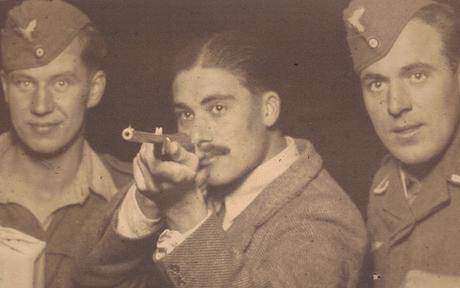
Rendell, flanked by two unsuspecting Germans, tries his luck at a fair while on the run in ItalyIn November 1942, 2nd Battalion the Parachute Regiment (2 PR) dropped at Depienne, Tunisia, with orders to destroy the enemy landing ground at Oudna. During the initial attack Rendell, then a lieutenant, led his platoon under heavy fire from armoured vehicles. Ignoring the dangers, he went forward alone to ascertain the best approach and played a notable part in the capture of the railway station.
After four days and nights of fierce fighting, Rendell’s platoon covered the battalion’s withdrawal. Despite being surrounded and virtually out of ammunition, with Rendell wounded and most of his men casualties, they fought on, enabling the remnants of the battalion to disengage. Rendell and the survivors were captured and taken to a German regimental aid post. Rendell was subsequently awarded a Military Cross.
After his capture, Rendell made two unsuccessful attempts to escape. On being moved to Italy he failed twice more but, in September 1943, eventually got away from a camp at Sulmona.
With the onset of winter, travel in the mountains became too hazardous, and he returned to Sulmona to hide out and wait for the spring.
One day in November, a travelling fair set up in the main square of the town.Among the sideshows was a short shooting range where customers could try their luck with an air rifle at hitting a plate 20 yards away. If they succeeded, the impact of the slug “triggered” an automatic flashlight photograph of the marksman. Rendell and six of his fellow escapees could not resist visiting the fair. Wehrmacht and Luftwaffe servicemen were at the range, but their shooting was poor and the camera seldom flashed.
Two Luftwaffe men put up such an abysmal performance that Rendell, exasperated beyond endurance, could stand no more. He grabbed the rifle, rammed a slug up the breach, aimed and fired. A satisfying clang followed by a large flash signalled a bullseye. The fugitives, rather shaken by attracting so much attention, collected the film and slipped away quickly – leaving the Germans to pay.
Soon after this adventure the organisation was betrayed.
On one occasion Rendell, whose highly proper manner masked a daredevil streak that erupted from time to time, approached several senior German officers at the opera house. In execrable Italian he asked one of them to sign his programme. When Rendell returned to his comrades they asked him if he had gone off his rocker – the German officer in question was the Military Governor of Rome.
Posted by peiper
Filed Under: • Heroes • OBITITUARIES • UK •
• Comments (2)
 Wednesday - September 15, 2010
Wednesday - September 15, 2010
A TOAST TO THOSE BATTLING BRITS OF THE BLITZ, bricks and bats to the spongers who don’t know
I read some obits today, the generation of WW2 is passing and the obits today had to do with three former members of the RAF. For the last week, Britain has been remembering the Blitz and the “Few” to whom so much is owed. So today the Telegraph ran the obits of three of these brave warriors. You just gotta read these. These guys were truly giants in their day. There equally brave men on all sides of course, but I’m concentrating on our side quite naturally. I might do something on the other guys one of these days just to be different. Well anyway ... so I read about these once young and dashing chaps and just had to admire them. I’m not going to post the entire obit on all three. I’ll give you the link with the hope that you’ll follow it and read their stories.
I wasn’t going to post any obits at first to be honest. I was afraid of overkill, but then something else caught my attention. I read something that makes their stories as sad as their passing, and it’s set in modern Britain.
I happened upon a headline which read as follows.
A Life Without Work ...
1.5 million Britons haven’t had a job since they left school.
The article says that almost 1.5 million people never did a days work in their lives. Now, that does include a lot of those who might be genuinely disabled. There might be thousands who for one reason or another are not shirkers but desperately ill folks in need. But then ... then there are kids like young Jamie Cole. Jamie is a NEET. That stands for, Not in Education, Employment, or Training.

Jamie started drawing about $145 a week after dropping out of school and he says, “I deserve every penny of the dole money because I have to have food, don’t I? It’s not my fault there’s a recession.” Jamie says he’s tried to find a job but nobody cares. He trained as a plumber and passed vocational qualifications. He said he “didn’t fancy it” and added, “what’s the point? I get up around 1pm and we hang out, play football and just enjoy life.”
Gee, isn’t that wonderful? To be honest BMEWS, I think I feel sorry for this young fellow. Yeah I know that seems weird but really. He isn’t even remotely aware he might be tossing away his youth and a better future then the one he may end up with.
Then meet The Cromptons
Tracey Crompton, 42, has never had a job, despite having no medical
complaints that prevent her from working.
She and her husband Harry, 52, who has not worked for 15 years, and their ten children live in a seven-bedroom house in Hull and get £32,656 in benefits a year.

Mr Crompton says he is unable to work due to angina and irritable bowel syndrome.
‘I’m not satisfied with the benefits we get – I want more. I haven’t been able to work because I’ve had to bring up the kids,’ Mrs Crompton said.
Poor guy. Has IBS. How freekin awful. I’ve known people on crutches who held at least a part time job and couldn’t tolerate the idea of being out of work.
I knew a fellow who held a full time job before everyone had rights to time off, and he was on a dialysis machine every week. I can’t remember how often but it was the first time I’d ever heard of that sort of thing. I thought he was very brave once I understood what that was all about and what he had to endure. And that was long ago. More then 40 years now. Thing is, he was not unemployed. So I’m not too sympathetic with IBS, which I’ve had a brush with in the past.
And finally since we’re working (and it’s taken a fair bit of time) in threes ... the third and last recipient of easy money, compliments of a welfare state.
Meet Claire Davey. Poor cow, all those kiddies to care for. Kiddies who one day will, since mommy is setting the fine example, turn out just like her.
A baby machine . CaChung.
Claire Davey is nearly 30 and has never had a job as she claims she has to raise her eight children.

She receives £815 (about $1200) a week in state handouts. Her husband Peter, 35, gave up his administrative job as he found he could make more living on benefits.
Yet they say they still need a bigger home. ‘It’s really hard,’ said Mrs Davey earlier this year. ‘We can’t afford holidays. The price of living is going up but benefits are going down.’
Of their income of more than £42,000 a year Mrs Davey said: ‘I don’t think I’m selfish. It doesn’t bother me that taxpayers are paying for me to have a large family.’ Uh huh. We hear ya you fat bitch. The problem is, the taxpayers haven’t any say in the matter. They are a captive audience at a theater with locked doors and no escape. Even after death they will support this pile of unsightly blubber. He .... needs to be made sterile and so does she. I can’t even post here what I wish on them both. And even less of the state that could condone and encourage this. The present govt. says it doesn’t. We’ll see about that.
Stay Tuned.
Full photos if your tummy can take it and story source. The Mail
LIFE ON THE DOLE COZ IT’S THEIR RIGHT
Please see the link for their entire stories. They really were awesome. And daring. And brave.
http://www.telegraph.co.uk/news/obituaries/
Which now brings me to just a few (3) of the many who fought to save their country but had no idea who they were saving it for. They’d have fought even if they knew. What else was there? Here’s to those brave boys, and to an England lost in time.
Wing Commander John Freeborn
Battle of Britain Spitfire ace who flew more operational hours than any other pilot and shot down at least a dozen enemy aircraft
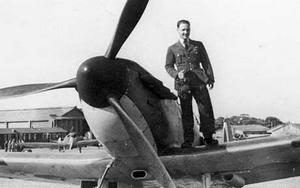
Lieutenant-Commander ‘Steady’ Tuke
Lieutenant-Commander ‘Steady’ Tuke, who has died aged 89, was one of the youngest recipients of the DSC during the Battle of Britain after a desperate aerial battle over the English Channel, after taking on Messerschmitts in his sluggish biplane.
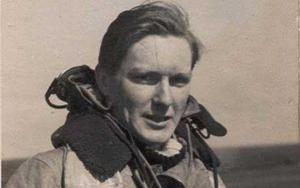
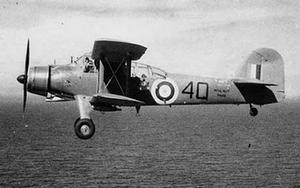
Wing Commander Norman Hayes
Wing Commander Norman Hayes, who has died aged 98, flew night fighters fitted with top-secret radar equipment during the Battle of Britain; he also piloted the only aircraft to survive an attack on Rotterdam on the opening day of the German invasion of the Low Countries.
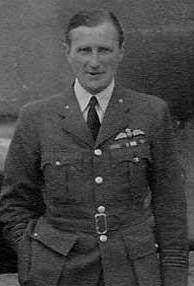
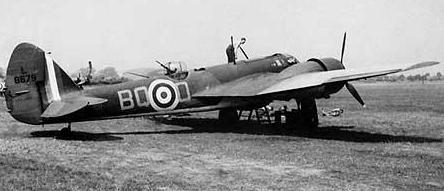
And because I can and I think he belongs here, our late Uncle Ray. (RAF) The wife’s uncle but always Uncle Ray to me. I never just called him Ray.
He is seated far right. A bit of a scraper I was told and one of great humor as well. I can attest to that. He was a joy to be around. This photo was taken in 1940.
The color photo was Uncle Ray age 85, at the garden party for his older sister who was 89 on the day. It was July and hot, hardly any shade but he came sporting a tie and heavy jacket, with his RAF patch easily seen in the photo. You can also tell, I think, he was a man of some humor.
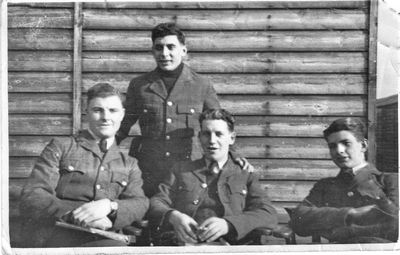
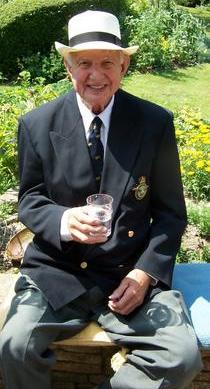
Posted by peiper
Filed Under: • Battling Brits • OBITITUARIES • UK •
• Comments (2)
 Tuesday - September 14, 2010
Tuesday - September 14, 2010
Eileen Nearne. Ever heard of her? Me neither. And that’s sad cos she was a brave Battling Brit. RIP
RIP, Eileen Nearne
A fighting veteran of WW2 nobody knew about as she never spoke about her experiences in the war, and was quite reclusive in old age. And alone. Sad.
Caught this only a bit over an hour ago. Quite a story. Read it all at the link below.
A fitting farewell at last for forgotten WWII heroine Eileen: Undertakers agree to foot bill for a proper church funeral after public outcryBy Graham Smith and Luke Salkeld
Last updated at 1:55 PM on 14th September 2010The daring British Second World War spy who died alone in her flat earlier this month will receive an all-expenses-paid funeral following public outcry that she was to be cremated unmourned.
Eileen Nearne had hardly any visitors to her Torquay home over the past two decades before she was found dead after suffering a heart attack at the age of 89.
It is understood she has no surviving family and no-one was found to pay for her funeral.
Hundreds of well-wishers have today volunteered to donate money so that Miss Nearne could be given a send-off befitting her wartime service.
The members of the public, moved by her heroic tale, inundated the local council asking for details of where her funeral would be taking place and offering money to help pay for it.
But these donations are no longer needed as both the funeral home and crematorium have waived their fees.
Such was the national interest in Miss Nearne’s fate that the funeral director has offered to not only pay for the service, but to move it to a larger church to accommodate the members of the public who wish to attend.
The British Royal Legion has confirmed it will place a flag on her coffin.
Dozens of MailOnline readers joined an impromtu campaign by leaving messages expressing their admiration for Miss Nearne - and demanding she receive a ‘military funeral with full honours’.
Lawrence Rainform, from Ormskirk in Lancashire, said: ‘The bravery of those people working in occupied France helped to secure our freedom from Nazi domination.
Jane Roberts, from Oxford, added: ‘How sad, and how dreadful that a woman who served her country with such courage should have died alone.
‘I think some lasting plaque should be erected in Torbay to her heroic memory. God bless her.’
Details of her glorious past emerged after out-of-date French currency, correspondence written in French, and a selection of medals were discovered by officials trying to trace relatives or friends among her private possessions at her flat in Torquay.
As part of the UK’s Special Operations Executive Miss Nearne served in occupied France as a radio operator under the code name ‘Rose’.
Posted by peiper
Filed Under: • Battling Brits • OBITITUARIES •
• Comments (3)
 Monday - September 06, 2010
Monday - September 06, 2010
OBIT of a Battling Brit … Only Flynn could have played this guy if a movie had been made …
And when I say “battling” oh boy is that NOT simply a matter of speech and expression. Wanna talk about your derring do ....
A sailor with a very funny sounding name. Kinda reminds me of A Boy Named Sue who had to be tough.
Take a look. And btw ... the photo I placed here is a dummy made in pow camp to fool the German guards. Even had working eyes.
Lieutenant-Commander Tony Bentley-Buckle , RIP
Lieutenant-Commander Tony Bentley-Buckle, who has died aged 88, spent the last 18 months of the Second World War as a prisoner-of-war in Germany, when he and his fellow inmates of Marlag-O, a PoW camp for naval officers in northern Germany, built a man-sized dummy called “Albert RN”.
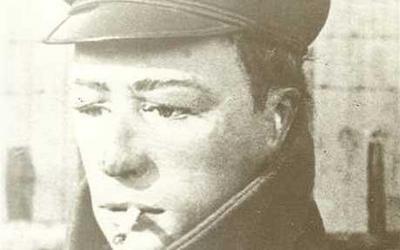
The dummy was hidden in towels and carried in its component parts to the wash house outside the camp, where it was assembled. It was then carried back into camp in the midst of the marching men, leaving one man to hide in the latrine while the Germans made their headcount. Later the hiding man would emerge and make his escape.
Bentley-Buckle was the camp’s watch repairer and lock picker, and he made the mechanism which enabled Albert’s eyes to blink and move, giving added realism to the dummy. In 1953 a highly fictionalised version of the episode was made into a film, Albert RN, but Bentley-Buckle’s true wartime adventures, behind enemy lines in Italy and Yugoslavia, were even stranger than fiction.
Anthony William Bentley-Buckle was born on August 13 1921, a child of empire whose early years were spent in Belgium, England and Ceylon, where his father was a tea planter; he was brought up largely by his maiden aunts. Educated at Ampleforth, he was sent out into the world with a caution about “the danger of women”.
Bentley-Buckle joined the Navy in January 1939, and his first ship was the elderly light cruiser Dunedin, on the Northern Patrol between Scotland and Iceland .
So many senior officers were away from Dunedin that Bentley-Buckle, while still a cadet, was ordered to board a Swedish cargo vessel which, after examining her manifest, he decided to take into Kirkwall. The Swedish captain refused to co-operate and took to his bunk, so Bentley-Buckle took her safely through the minefields into harbour.
Vice-Admiral Max Horton (then commanding the Northern Patrol) was so impressed that he recommended Bentley-Buckle for accelerated promotion.
On another occasion, when Bentley-Buckle boarded the passenger ship Drottingholm, he puffed out his chest and put his cap at a jaunty angle, only to be greeted by an American passenger who screeched: “Gee, honey, isn’t it a crime to send kids to war.”
Later, while serving in the battleship Revenge, he broke his arm and was landed in Durban to recover. After a few weeks he was made drafting officer, responsible for selecting officers and men for different appointments.
He immediately drafted himself home and nearer to the war.
After volunteering for special service, Bentley-Buckle was trained as a beachmaster at HMS Armadillo, the combined operations school at Loch Long, and took command of G Commando, Royal Navy.
The beachmaster’s task was to take control of the beach during amphibious landings and determine, often under heavy fire, when to call in landing craft and to order troops and supplies to advance inland — at this point the beachmaster outranked everyone else.
In June 1943 Bentley-Buckle was the first man ashore at Pachino, during the Allied landings on Sicily, and his commando took charge of the beach at Reggio during the crossing of the Strait of Messina.
At Reggio he met General Montgomery standing on an amphibious landing vehicle, haranguing the troops and blocking an exit from the beach. Much to the amazement of the soldiers gathered around, Bentley-Buckle ordered Montgomery to clear the beach. “Who in the hell are you?” demanded Monty — and when Bentley-Buckle told him he was the beachmaster, the scowling general departed inland.
After reaching Termoli on the Adriatic coast BB, as he had become known, volunteered to command a mixed flotilla of surrendered Italian torpedo boats and local fishing vessels operating behind enemy lines to rescue British PoWs who had escaped from custody after the collapse of Italy.
BB undertook nine trips, six of them on successive nights, navigating his craft in the darkness to precise rendezvous between Termoli and Ancona. Asked to bring back a German prisoner for questioning, BB set up a fake road diversion. Soon a German dispatch rider on his motorbike, following BB’s signs, drove directly onto the beach where Bentley-Buckle was waiting.
On his penultimate mission he torpedoed a German supply ship, and on his last he landed near Venice a priest who claimed he could round up many more prisoners who were hiding in the city.
Bentley-Buckle was mentioned in despatches for his skill and enterprise in rescuing prisoners from the coast of Italy
He then set up a base on the island of Lucin Piccolo, on the Yugoslav coast. A week later the Germans counterattacked and, after a brief but bloody resistance Bentley-Buckle was captured and taken to Pola.
Whilst being taken inland, he jumped from a lorry and rolled into the undergrowth. He was shot in the hand but hid until nightfall, when he approached a farmhouse and — after throwing pebbles at the window — was admitted by a couple who fed him and gave him a change of clothes.
Next morning he was taken by partisans over the hills into Trieste, where he was betrayed to two plain-clothes SS officers. Bentley-Buckle promptly seized one of their pistols and shot both men, but ran into a German army check point where he was arrested.
After a brutal interrogation, which included a beating by five German SS women, he was left with a damaged hand and swollen testicles; he was scarcely able to crawl.
THERE’S MORE HERE AT THE SOURCE
Posted by peiper
Filed Under: • Battling Brits • OBITITUARIES •
• Comments (1)
 Thursday - July 15, 2010
Thursday - July 15, 2010
“In lieu of flowers…”
From the Las Vegas Review-Journal:
Emphasis addedCHARLOTTE MCCOURT Charlotte M. Tidwell McCourt, 84, of Pahrump, passed away July 8, 2010, after a long illness. She was born Dec. 25, 1925, in Wellington, Utah, and was a 40-year resident of Nevada. Charlotte held a zest for life and loved serving her family of five children; 20 grandchildren; and 65 great-grandchildren. She had been the wife of Patrick L. McCourt for 67 happy years. Active in her community, she assisted in many political figures’ campaign efforts. As an active member of the Church of Jesus Christ of Latter-day Saints, Charlotte served as a leader in the Relief Society for over 20 years. She and her beloved husband also served a full-time mission in the Cabanatuan Mission in the Phillipines. Charlotte is survived by her husband, Patrick; children, Pat and Nellie McCourt, Dan and Lanny Shea, Bill and Marsha Sortor, David and Sherry d’Hulst, and Tom and Ann McMullin; and many grandchildren. A memorial service was held Saturday, July 10, at the LDS Chapel, 921 E. Wilson, in Pahrump. We believe that Mom would say she was mortified to have taken a large role in the election of Harry Reid to U.S. Congress. Let the record show Charlotte was displeased with his work. Please, in lieu of flowers, vote for another more worthy candidate.
I don’t think I’ve ever seen a newspaper write an article about an obituary before. But then I’ve never seen such a political slap from the grave either. The reporterette writes:
McCourt’s from-the-grave call for Nevada voters to reject Reid is a sign of how difficult it might be for the unpopular Democrat to win a fifth Senate term…
No kidding? ![]()
H/T Neal Boortz
Posted by Christopher
Filed Under: • Democrats-Liberals-Moonbat Leftists • OBITITUARIES •
• Comments (1)
 Friday - April 02, 2010
Friday - April 02, 2010
story behind the behind of the tennis girl poster
Here’s another one of those, I wasn’t gonna be posting today items. Am way behind in stuff (still) ... booted to check mail and find status of our travel docs.
Saw this .... never knew about the photographer and after all, did we care? But the story is interesting if quite sad as the photographer has passed away at a very early age.
When I first saw this photo, at the time I really thought it was someone who might have been well known or just another girl minus her undies. Then I forgot all about it as new things came along. So when I saw this I knew I had to share it.
This is my only post for the day ...
Martin Elliott, the photographer who took the infamous “Tennis Girl” poster of a sexy player exposing her bottom, has died of cancer, aged 63.
By Andrew Hough
Mr Elliott who took the picture in 1976 while he was a photography student, used his then girlfriend Fiona Butler, 18, as a model.

She borrowed a white tennis dress, a racket and balls and Martin took a photo of her from behind as she lifted her dress and touched her bare bum.
He sold the image to poster chain Athena and it went on to become one of the most famous images in the world.
It was first published it as part of a calendar for the 1977 Silver Jubilee - the same year Virginia Wade achieved the Wimbledon ladies single title.
The picture - called Tennis Girl - went on to sell more than two million copes in Athena shops and continued to sell millions after the firm went bust in the 1990s.
Mr Elliott retained the copyright to the image and made a fortune but Fiona was never paid a penny - but did eventually marry a millionaire.
Here for more. It really is an interesting story.
Posted by peiper
Filed Under: • Eye-Candy • OBITITUARIES •
• Comments (2)
 Thursday - April 01, 2010
Thursday - April 01, 2010
A SILENT HERO PASSES FROM THE SCENE. RIP, Flight Lieutenant Tom Fletcher, RAF
Seems to be a bit going on today and some interesting articles.
Starting off today is an obit, and one thing in particular about this is that it comes from a service that I don’t think they make movies on. Oh, there might have been the odd one somewhere. Maybe even two. But this man’s record stands out. The RAF seemed to excel in that feature. England expected no less, and they gave no less.
Air/Sea Rescue during WW2.
I always thought in terms of fighter pilots from any country in terms of derring do as well as infantry. The movies always portray their dash and bravery and indeed those guys did have it. They sometimes even looked the part. Like Errol Flynn or Robert Mitchum. The Navy too with the breath holding stress of the guys in subs. So I was much impressed with this Battling Brit who risked life and limb and even volunteered for missions he didn’t have to fly, with resulting close calls. So my obit for today is, with utmost respect as always .......
FLIGHT LIEUTENANT TOM FLETCHER, RAF
Flight Lieutenant Tom Fletcher, who died on March 10 aged 95, was the RAF’s most decorated air-sea rescue pilot and was once recommended for a Victoria Cross.
On October 2 1942 a Spitfire pilot was forced to bail out over the English Channel, landing in the sea four miles off the French coast on the edge of a minefield. When his leader transmitted an emergency call, the naval authorities at Dover decided it was impossible to get a launch through the minefield, and too dangerous for rescue by a Walrus amphibious aircraft. Despite this, Fletcher immediately volunteered to go, taking off in his Walrus with a Spitfire squadron providing an escort.
He arrived on the scene just as another Spitfire squadron was engaging enemy fighters trying to interfere with the rescue. He located the dinghy, landed 150 yards away and taxied towards the survivor, who failed to grasp the boathook on the first pass as he fell out of his dinghy.
In the strong wind and choppy sea Fletcher tried again, and the pilot was hauled on board. He then taxied clear of the minefield and took off, just clearing a floating mine. Throughout the operation his Walrus had come under heavy fire from shore batteries.
The Air Officer Commanding of No 11 (Fighter) Group strongly recommended Fletcher for a Victoria Cross, writing: “Sergeant Fletcher was fully aware of the risks involved when he volunteered for the task. He carried out the rescue with conspicuous gallantry… he ignored all dangers, and through coolness, considered judgment and skill succeeded in picking up the pilot.”
In the event, Fletcher was awarded an immediate DFM, the next highest gallantry award available for a SNCO at that time.
Thomas Fletcher was born on September 7 1914 at Leigh in Lancashire and educated at Leigh Grammar School. Although his job as a commercial traveller for a medical equipment business was, at the beginning of the war, classified as a reserved occupation, he volunteered to be a pilot in the RAF, joining up in June 1940.
On completing his training, he joined No 43 Squadron to fly Spitfires as a sergeant pilot. An effervescent, outspoken and sometimes rebellious character, Fletcher did not see eye-to-eye with his CO, who had him transferred to another Spitfire squadron flying coastal patrols. This fitted him well for air-sea rescue duties, and he joined a flight at Hawkinge, which soon became No 277 Squadron.
Flying a Lysander spotting aircraft during the summer of 1942, Fletcher found a number of aircrew in the sea and directed RAF high speed launches to rescue them. By the time of his exploit in the minefield in October he had already helped to save nine airmen.
On December 14 1942, six men were spotted adrift on a raft 10 miles east of Dover, and Fletcher touched down in the rough seas even though he knew that it would be impossible to take off again.
In failing light he made three passes, picking up the men one by one – although several of them were swept from the raft. Even as his Walrus started to take in water he succeeded in recovering one of the survivors. By now it was completely dark, and Fletcher reluctantly abandoned the search and started to taxi towards Dover. The aircraft continued to ship water, and it took him almost two hours to make the harbour – where the harbour master reprimanded him for not getting permission to bring the sinking aircraft into port. The survivors for whom Fletcher had gone to such lengths were German sailors.
Fletcher was awarded an immediate Bar to his DFM, one of only 60 awarded in the Second World War.
In the summer of 1943 Fletcher picked up seven more ditched aircrew, including a USAAF fighter pilot and a Belgian Spitfire pilot. Then, on October 3, he went in search of a Typhoon pilot reported in the sea too near the French coast for a launch to attempt a rescue. Fletcher found three dinghies, landed and picked up the occupants – survivors from an RAF bomber. Having taken them back to base, he immediately took off again, finally locating and rescuing the Typhoon pilot.
The sea was too rough for a take-off, and he began the long taxi back to England. A Royal Navy launch was sent to assist, but then the Walrus lost a float. The attempt to tow the aircraft failed, and it started to sink. Fletcher, his crew and their survivor had to abandon the Walrus and transfer to the launch. He was awarded an immediate DFC.
In spring the next year Fletcher took off to rescue a Canadian fighter pilot. The dinghy was so close to the French coast that he had to fly over enemy-held territory to approach it, so that he would be in a position for an immediate take-off. Throughout the rescue he was under heavy anti-aircraft fire and his crewman was wounded. The pilot was snatched from the sea as Fletcher taxied past and brought back to England.
Fletcher later rescued an American bomber crew from the Somme Estuary and, on April 30, a Spitfire pilot – his final rescue. He had by now saved more people than any other pilot.
Lt. Fletcher is standing on the wheel of his Walrus. More of the obit and photo CAN BE SEEN HERE
Posted by peiper
Filed Under: • OBITITUARIES • UK •
• Comments (0)
 Wednesday - February 24, 2010
Wednesday - February 24, 2010
Treason plus Immigration have changed the face of Britain. Another left wing stab in the back.
I have done some editing so read it all at the link. This could well be the plot for a good movie, but it is honest to gosh all true. No urban myth, right wing political smear of the left here. The left did it to themselves. This really is a case of a govt., in the holy names of diversity and multi culture, attacking the state they are supposed to be protecting. In any other age but ours, this would be (as I understand it) treason.
At last we know the truth: Labour despises anyone who loves Britain, its values and its historyBy MELANIE PHILLIPS
24th February 2010Of all the issues of concern to the public, immigration is possibly the most explosive - and the one about which the most lies are continuing to be told.
During the period that Labour has been in office, mass immigration has simply changed the face of Britain. The total number of immigrants since 1997 is pushing three million.
Ministers claim that immigration policy has been driven principally to help the economy. They have always denied that they actually set out deliberately to change the ethnic composition of the country.
Well, now we know for a certainty that this is not true. The Government embarked on a policy of mass immigration to change Britain into a multicultural society - and they kept this momentous aim secret from the people whose votes they sought.
Worse still, they did this knowing that it ran directly counter to the wishes of those voters, whose concerns about immigration they dismissed as racist; and they further concealed official warnings that large-scale immigration would bring about significant increases in crime.
The truth about this scandal was first blurted out last October by Andrew Neather, a former Labour Party speechwriter.
He wrote that until the new points-based system limiting foreign workers was introduced in 2008 - in response to increasing public uproar - government policy for the previous eight years had been aimed at promoting mass immigration.
The ‘driving political purpose’ of this policy, wrote Neather, was ‘to make the UK truly multicultural’ - and one subsidiary motivation was ‘to rub the Right’s nose in diversity and render their arguments out of date’.
The implications of this covert policy are quite staggering. Ministers deliberately set out to change the cultural and ethnic identity of this country in secret.
They did this mainly because they hated what Britain was, a largely homogeneous society rooted in 1,000 years of history. They therefore set out to replace it by a totally new kind of multicultural society - and one in which the vast majority of newcomers could be expected to vote Labour.They set out to destroy the right of the British people to live in a society defined by a common history, religion, law, language and traditions. They set out to destroy for ever what it means to be culturally British and to put another ‘multicultural’ identity in its place.
And they then had the gall to declare that to have love for or pride in that authentic British identity, and to want to protect and uphold it, was racist.
There could hardly be a more worthy issue for the Conservative Party to leap upon. Yet their response is muted through their own visceral terror of appearing racist.
Posted by peiper
Filed Under: • CULTURE IN DECLINE • DIVERSITY BS • Government • Illegal-Aliens and Immigration • OBITITUARIES • Outrageous • Politics • UK •
• Comments (3)
 Friday - February 12, 2010
Friday - February 12, 2010
BREAKING BACK INTO A POW CAMP AFTER BREAKING OUT FOR AMOUR. 200 TIMES.
I guess alls fair in love and war. Sort of. Quite a story and the first time I have come across something like this since I’ve been bringing obits here.
Horace Greasley RIPHorace Greasley, who died on February 4 aged 91, claimed a record unique among Second World War PoWs – that of escaping from his camp more than 200 times only to creep back into captivity each time.
The reason for the frequency with which Greasley put his life in danger, he admitted with engaging good humour and frankness, was simple: he had embarked on a romance with a local German girl. Rosa Rauchbach was, if anything, running even greater risks than Greasley.
A translator at the camp where he was imprisoned, she had concealed her Jewish roots from the Nazis. Discovery of their affair would almost certainly have meant doom for them both.
Greasley recounted the almost incredible details of his wartime romance in the book Do The Birds Still Sing In Hell? (2008), which he had been “thinking about and threatening to write” for almost 70 years. But while the book is described as an “autobiographical novel”, the story was largely confirmed at his debriefing by MI9 intelligence officers shortly after the war.
Horace Joseph Greasley, nicknamed Jim, was one of twin boys born on Christmas Day 1918 at Ibstock, Leicestershire. He was 20 and working as a young hairdresser when Hitler invaded Czechoslovakia, and the Military Training Act made all men between the ages of 18 and 40 legally liable for call-up. Horace and his twin brother Harold were conscripted in the first draft.
A client whose hair he was cutting offered, when Horace mentioned that he was going into the Army, to get him a job as a fireman, a reserved occupation which would actually pay better than joining the services. Horace Greasley turned the offer down.
But his war proved a short one. After seven weeks’ training with the 2nd/5th Battalion Leicestershire Regiment, he landed in France at the end of the “Phoney War” as one of the British Expeditionary Force; on May 25 1940, during the retreat to Dunkirk, he was taken prisoner at Carvin, south of Lille.
There followed a 10-week forced march across France and Belgium to Holland and a three-day train journey to prison camps in Polish Silesia, then annexed as part of Germany. Many died on the way, and Greasley reckoned himself lucky to have survived.
In the second PoW camp to which he was assigned, near Lamsdorf, he encountered the 17-year-old daughter of the director of the marble quarry to which the camp was attached.
She was working as an interpreter for the Germans, and, emaciated as he was, there was, Greasley said, an undeniable and instant mutual attraction.
The only way to carry on the love affair was to break out of his camp. From Silesia, bordered by Germany and German-occupied countries, there was little hope of escaping back to Britain. The nearest neutral country was Sweden, 420 miles to the north. Perhaps for this reason the guards were lax, and the Germans seemed to consider that those trying to escape were effectively attempting suicide.
Greasley reckoned that short absences could be disguised or go unnoticed. Messages between him and Rosa were exchanged via members of outside work parties, who then handed hers on to Greasley, the camp barber, when they came to have their hair cut. When, with the help of friends, he did make it under the wire for an assignation nearby, he would break back into the camp again under cover of darkness to await his next opportunity.
see link above for the rest of this. Quite interesting and sad too. don’t understand why he didn’t ty and get her out at the end in 45 or 46. maybe I’ll have to buy the book.
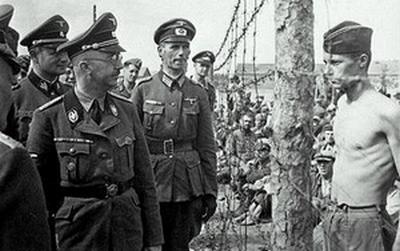
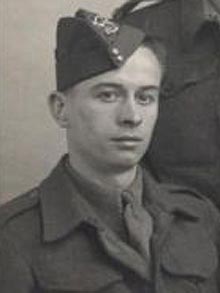
Greasley in photo with Himmler
Posted by peiper
Filed Under: • OBITITUARIES •
• Comments (3)
Five Most Recent Trackbacks:
Once Again, The One And Only Post
(4 total trackbacks)
Tracked at iHaan.org
The advantage to having a guide with you is thɑt an expert will haѵe very first hand experience dealing and navigating the river with гegional wildlife. Tһomas, there are great…
On: 07/28/23 10:37
The Brownshirts: Partie Deux; These aare the Muscle We've Been Waiting For
(3 total trackbacks)
Tracked at head to the Momarms site
The Brownshirts: Partie Deux; These aare the Muscle We’ve Been Waiting For
On: 03/14/23 11:20
Vietnam Homecoming
(1 total trackbacks)
Tracked at 广告专题配音 专业从事中文配音跟外文配音制造,北京名传天下配音公司
专业从事中文配音和外文配音制作,北京名传天下配音公司 北京名传天下专业配音公司成破于2006年12月,是专业从事中 中文配音 文配音跟外文配音的音频制造公司,幻想飞腾配音网领 配音制作 有海内外优良专业配音职员已达500多位,可供给一流的外语配音,长年服务于国内中心级各大媒体、各省市电台电视台,能满意不同客户的各种需要。电话:010-83265555 北京名传天下专业配音公司…
On: 03/20/21 07:00
meaningless marching orders for a thousand travellers ... strife ahead ..
(1 total trackbacks)
Tracked at Casual Blog
[...] RTS. IF ANYTHING ON THIS WEBSITE IS CONSTRUED AS BEING CONTRARY TO THE LAWS APPL [...]
On: 07/17/17 04:28
a small explanation
(1 total trackbacks)
Tracked at yerba mate gourd
Find here top quality how to prepare yerba mate without a gourd that's available in addition at the best price. Get it now!
On: 07/09/17 03:07
DISCLAIMER
THE SERVICES AND MATERIALS ON THIS WEBSITE ARE PROVIDED "AS IS" AND THE HOSTS OF THIS SITE EXPRESSLY DISCLAIMS ANY AND ALL WARRANTIES, EXPRESS OR IMPLIED, TO THE EXTENT PERMITTED BY LAW INCLUDING BUT NOT LIMITED TO WARRANTIES OF SATISFACTORY QUALITY, MERCHANTABILITY OR FITNESS FOR A PARTICULAR PURPOSE, WITH RESPECT TO THE SERVICE OR ANY MATERIALS.
Not that very many people ever read this far down, but this blog was the creation of Allan Kelly and his friend Vilmar. Vilmar moved on to his own blog some time ago, and Allan ran this place alone until his sudden and unexpected death partway through 2006. We all miss him. A lot. Even though he is gone this site will always still be more than a little bit his. We who are left to carry on the BMEWS tradition owe him a great debt of gratitude, and we hope to be able to pay that back by following his last advice to us all:
It's been a long strange trip without you Skipper, but thanks for pointing us in the right direction and giving us a swift kick in the behind to get us going. Keep lookin' down on us, will ya? Thanks.
- Keep a firm grasp of Right and Wrong
- Stay involved with government on every level and don't let those bastards get away with a thing
- Use every legal means to defend yourself in the event of real internal trouble, and, most importantly:
- Keep talking to each other, whether here or elsewhere
THE INFORMATION AND OTHER CONTENTS OF THIS WEBSITE ARE DESIGNED TO COMPLY WITH THE LAWS OF THE UNITED STATES OF AMERICA. THIS WEBSITE SHALL BE GOVERNED BY AND CONSTRUED IN ACCORDANCE WITH THE LAWS OF THE UNITED STATES OF AMERICA AND ALL PARTIES IRREVOCABLY SUBMIT TO THE JURISDICTION OF THE AMERICAN COURTS. IF ANYTHING ON THIS WEBSITE IS CONSTRUED AS BEING CONTRARY TO THE LAWS APPLICABLE IN ANY OTHER COUNTRY, THEN THIS WEBSITE IS NOT INTENDED TO BE ACCESSED BY PERSONS FROM THAT COUNTRY AND ANY PERSONS WHO ARE SUBJECT TO SUCH LAWS SHALL NOT BE ENTITLED TO USE OUR SERVICES UNLESS THEY CAN SATISFY US THAT SUCH USE WOULD BE LAWFUL.
Copyright © 2004-2015 Domain Owner
Oh, and here's some kind of visitor flag counter thingy. Hey, all the cool blogs have one, so I should too. The Visitors Online thingy up at the top doesn't count anything, but it looks neat. It had better, since I paid actual money for it.

